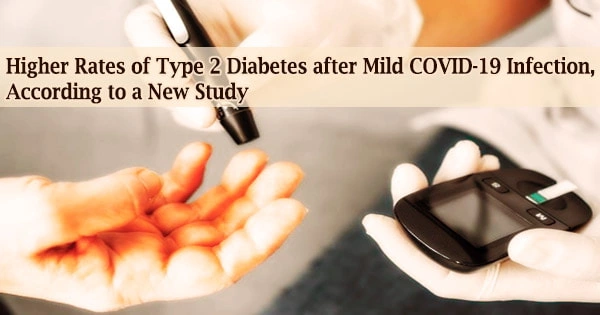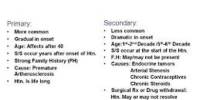The European Association for the Study of Diabetes (EASD) journal Diabetologia recently released a new study that may reveal a link between moderate COVID-19 instances and a subsequent type 2 diabetes diagnosis.
The analysis of health records from 1,171 general and internal medicine practices across Germany was conducted by Professor Wolfgang Rathmann and Professor Oliver Kussfrom the German Diabetes Center at Heinrich Heine University, Dusseldorf, Germany, and Professor Karel Kostev (IQVIA, Frankfurt, Germany) found that adults who recover from mostly mild COVID-19 appear to have a significantly higher risk of developing type 2 diabetes than a matched control group who had other types of respiratory infections, which are also frequently caused by viruses.
If these findings are validated, experts say that diabetes screening for people who have recovered with mild COVID-19 should be advised. Numerous ongoing investigations, including those related to the CoviDiab registry and other studies involving so-called “long COVID,” are also looking into this potential connection between COVID-19 and diabetes.
Serious COVID-19 problems are more likely to occur in diabetics. Generally speaking, when exposed to any virus, people with diabetes are more prone to experience more severe symptoms and problems.
According to earlier research, SARS-CoV-2-induced inflammation may harm insulin-producing beta cells, leading them to die or affect how they function, which would lead to severe hyperglycemia (high blood glucose). According to the most recent data, veterans who had COVID-19 were around 40% more likely than veterans in the control groups to develop diabetes up to a year later.
This indicated that around 13 more patients in the COVID-19 group had a diabetes diagnosis for every 1,000 study participants in each group. The majority of cases were type 2 diabetes, in which the body stops producing enough insulin or becomes resistant to it.
It is also believed that inflammation in the body may contribute to tissues becoming less responsive to insulin. Lockdown-induced sedentary behaviors might also be at fault. This could explain why COVID-19 patients without a history of diabetes have developed new-onset hyperglycemia and insulin resistance.
Uncertainty exists over whether these metabolic alterations are only transient or whether people with COVID-19 may be more susceptible to developing chronic diabetes. Furthermore, there are few research examining the prevalence of diabetes following recovery from moderate episodes of COVID-19.
An additional 8 out of every 1,000 COVID-19 patients who avoided hospitalization had diabetes a year later compared to those who were not infected. After contracting SARS-CoV-2, those with a high body mass index, a measure of obesity, and a significant risk factor for type 2 diabetes had a risk of acquiring diabetes that was more than doubled.
The study team examined electronic health records from the Disease Analyzer database, which contained data on 8.8 million adults who attended 1,171 general and internal medicine practices throughout Germany between March 2020 and January 2021, in order to add to the existing evidence. This includes 35,865 patients who had COVID-19 diagnoses.
The risk of abnormally high blood sugar in individuals with COVID-19 is most likely a continuum, depending on risk factors such as injury to beta cells, an exaggerated inflammatory response, and changes in pandemic-related weight gain and decreased physical activity.
Professor Oliver Kuss
When individuals were matched for sex, age, health insurance coverage, index month of COVID-19 or AURI diagnoses, and co-morbidities, the incidence of diabetes after COVID-19 was compared with a cohort of people (average age 43 years; 46% women) who were diagnosed with an acute upper respiratory tract infection (AURI) (but not COVID-19) within the same timeframe (obesity, high blood pressure, high cholesterol, heart attack, stroke). The incidence rate ratios (IRRs) for type 2 diabetes and other types of diabetes were calculated using regression models.
Excluded from the study were people who had ever had COVID-19, diabetes, or who had used corticosteroids within 30 days of the index dates. The number of hospitalizations was comparable in both groups over an average follow-up of 119 days for COVID-19 and 161 days for AURI (COVID-19: 3.2 percent vs controls: 3.1 percent; the median number of hospital stays: 1 in both cohorts).
The incidence rate ratio (IRR) for new cases of type 2 diabetes was reported to be 1.28 in patients who tested positive for COVID-19 compared to those with an AURI (15.8 vs. 12.3 per 1000 people per year).
Simply put, this indicates that the COVID group had a 28 percent higher relative chance of acquiring type 2 diabetes than the AURI group. Other unidentified kinds of diabetes did not result in a rise in the IRR for the COVID group.
According to lead author Professor Wolfgang Rathmann, “COVID-19 infection may cause diabetes by upregulating the immune system after remission, which may induce pancreatic beta cell dysfunction and insulin resistance. Alternatively, patients may have already been at risk for developing diabetes due to obesity or prediabetes, and the stress COVID-19 put on their bodies accelerated it.
“The risk of abnormally high blood sugar in individuals with COVID-19 is most likely a continuum, depending on risk factors such as injury to beta cells, an exaggerated inflammatory response, and changes in pandemic-related weight gain and decreased physical activity,” adds co-author Professor Oliver Kuss.
Prof Rathmann adds: “Since the COVID-19 patients were only followed for about three months, further follow-up is needed to understand whether type 2 diabetes after mild COVID-19 is just temporary and can be reversed after they have fully recovered, or whether it leads to a chronic condition.”
The majority of persons with mild COVID-19 are unlikely to get type 2 diabetes, but the authors advise anyone who has recovered from COVID-19 to be aware of the warning signs and symptoms, including fatigue, frequent urination, and increased thirst, and to get treatment immediately away.
The study’s limitations, according to the authors, include a lack of data on hospitalizations and COVID-19 diagnoses outside of general practice (such as in hospitals or COVID-19 testing facilities), which may restrict the precision of the findings.
Similar to how they were unable to control for body mass index due to the lack of data, they were also unable to explore the incidence of type 1 diabetes given the low number of patients. They conclude by pointing out that their results might not apply to other populations.
















